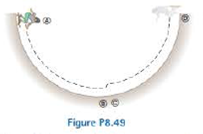
A skateboarder with his board can be modeled as a particle of mass 76.0 kg, located at his center of mass (which we will study in Chapter 9). As shown in Figure P8.49, the skateboarder starts from rest in a crouch-ing position at one lip of a half-pipe (point Ⓐ). The half-pipe is one half of a cylinder of radius 6.80 m with its axis horizontal. On his descent, the skateboarder moves without friction so that his center of mass moves through one quarter of a circle of radius 630 m. (a) Find his speed at the bottom of the half-pipe (point Ⓑ (b) Immediately after passing point Ⓑhe stands up and raises his arms, lifting his center of mass from 0.500 in to 0.950 m above the concrete (point ©). Next, the skateboarder glides upward with his center of mass moving in a quarter circle of radius 5.85 m. His body is horizontal when he passes point Ⓓ, the far lip of the half-pipe. As he passes through point Ⓓ, the speed of the skateboarder is 5.14 m/s. How much chemical potential energy in the body of the skateboarder was converted to mechanical energy in the skateboarder—Earth system when he stood up at point Ⓑ? (c) How high above point Ⓓ does he rise? Caution: Do not try this stunt yourself without the required skill and protective equipment.

Figure P8.49
(a)
The speed at the bottom of the half pipe.
Answer to Problem 8.49AP
The speed at the bottom of the half pipe is
Explanation of Solution
Given info: The mass of the particle is
The formula to calculate the initial gravitational potential energy of the particle at point
Here,
Thus, the initial gravitational potential energy of the particle at point
The formula to calculate the gravitational potential energy is,
Here,
The height of the particle at point
Substitute 0 for
Thus, the gravitational potential energy at point
The formula to calculate the initial kinetic energy of the particle is,
Here,
The initial velocity of the particle is 0 as the particle is at rest then the kinetic energy at point
Substitute 0 for
Thus, the kinetic energy of the particle at point
The formula to calculate the kinetic energy of the particle at point
Here,
Thus, the kinetic energy at point
The formula to calculate the law of conservation of energy is,
Here,
Substitute
Substitute
Rearrange the above formula for
Substitute
Conclusion:
Therefore, the speed at the bottom of the half pipe is
(b)
The amount of chemical potential energy converted into mechanical energy in the skateboarder- Earth system when he stood up at point
Answer to Problem 8.49AP
The amount of chemical potential energy converted into mechanical energy in the skateboarder- Earth system when he stood up at point
Explanation of Solution
Given info: The mass of the particle is
The formula to calculate the centripetal acceleration of the particle at the point
Here,
Substitute
Thus, the centripetal acceleration of the particle at point
The formula to calculate the normal force acting on the particle at point
Here,
Substitute
Thus, the value of normal force acting on the particle at point
The formula to calculate the chemical energy of the skateboarder converted into mechanical energy at point
Here,
Substitute
Conclusion:
Therefore, the amount of chemical potential energy converted into mechanical energy in the skateboarder- Earth system when he stood up at point
(c)
The height above point
Answer to Problem 8.49AP
The height above point
Explanation of Solution
Given info: The mass of the particle is
The formula to calculate the initial gravitational potential energy of the particle at point
Here,
Thus, the initial gravitational potential energy of the particle at point
The formula to calculate the gravitational potential energy is,
Here,
Thus, the gravitational potential energy at point
The formula to calculate the initial kinetic energy of the particle is,
Here,
Thus, the kinetic energy of the particle at point
The formula to calculate the kinetic energy of the particle at point
Here,
Thus, the kinetic energy at point
The formula to calculate the law of conservation of energy is,
Here,
Substitute
Substitute
Substitute
Conclusion:
Therefore, the height above point
Want to see more full solutions like this?
Chapter 8 Solutions
EBK PHYSICS FOR SCIENTISTS AND ENGINEER
- Suppose a toy boat moves in a pool at at a speed given by v=1.0 meter per second at t=0, and that the boat is subject to viscous damping. The damping on the boat causes the rate of speed loss to be given by the expression dv/dt=-2v. How fast will the boat be traveling after 1 second? 3 seconds? 10 seconds? Use separation of variables to solve this.arrow_forwardWhat functional form do you expect to describe the motion of a vibrating membrane without damping and why?arrow_forwardIf speed is tripled, how much larger will air drag become for an object? Show the math.arrow_forward
- What does it tell us about factors on which air drag depends if it is proportional to speed squared?arrow_forwardWhat is the net charge on a sphere that has the following? x (a) 5.75 × 106 electrons and 8.49 × 106 protons 4.39e-13 What is the charge of an electron? What is the charge of a proton? C (b) 200 electrons and 109 protons 1.60e-10 What is the charge of an electron? What is the charge of a proton? Carrow_forwardA spider begins to spin a web by first hanging from a ceiling by his fine, silk fiber. He has a mass of 0.025 kg and a charge of 3.5 μC. A second spider with a charge of 4.2 μC rests in her own web exactly 2.1 m vertically below the first spider. (a) What is the magnitude of the electric field due to the charge on the second spider at the position of the first spider? 8.57e3 N/C (b) What is the tension in the silk fiber above the first spider? 0.125 How does the electric field relate to the force? How do you calculate the net force? Narrow_forward
- Point charges of 6.50 μC and -2.50 μC are placed 0.300 m apart. (Assume the negative charge is located to the right of the positive charge. Include the sign of the value in your answers.) (a) Where can a third charge be placed so that the net force on it is zero? 0.49 m to the right of the -2.50 μC charge (b) What if both charges are positive? 0.185 xm to the right of the 2.50 μC chargearrow_forwardc = ad Find the electric field at the location of q, in the figure below, given that q₁ = 9₁ = 9₁ = +4.60 nC, q=-1.00 nC, and the square is 20.0 cm on a side. (The +x axis is directed to the right.) magnitude direction N/C ° counterclockwise from the +x-axis 9a % 9 9barrow_forwardPlastic beads can often carry a small charge and therefore can generate electric fields. Three beads are oriented such that 92 is between q₁ and 93. The sum of the charge on 9₁ and 92 is 9₁ + 92 = −2.9 µС, and the net charge of the system of all three beads is zero. E field lines 93 92 What charge does each bead carry? 91 92 -1.45 What is the net charge of the system? What charges have to be equal? μC 2.9 ✓ What is the net charge of the system? What charges have to be equal? μC 93 2.9 μεarrow_forward
- A spider begins to spin a web by first hanging from a ceiling by his fine, silk fiber. He has a mass of 0.025 kg and a charge of 3.5 μC. A second spider with a charge of 4.2 μC rests in her own web exactly 2.1 m vertically below the first spider. (a) What is the magnitude of the electric field due to the charge on the second spider at the position of the first spider? 8.57e3 N/C (b) What is the tension in the silk fiber above the first spider? 0.275 How does the electric field relate to the force? How do you calculate the net force? Narrow_forwardPlastic beads can often carry a small charge and therefore can generate electric fields. Three beads are oriented such that 92 is between 91 system of all three beads is zero. E field lines 91 92 93 X What charge does each bead carry? 91 = 92 = ?2.9 0 μC × What is the net charge of the system? What charges have to be equal? μC 93 2.9 με and 93. The sum of the charge on 91 and 92 is 91 +92 = -2.9 μC, and the net charge of thearrow_forwardAn electron has an initial speed of 5.26 x 100 m/s in a uniform 5.73 x 105 N/C strength electric field. The field accelerates the electron in the direction opposite to its initial velocity. (a) What is the direction of the electric field? opposite direction to the electron's initial velocity same direction as the electron's initial velocity not enough information to decide × What is the direction of the force on the electron? How does it compare to the direction of the electric field, considering the sign of the electron's charge? (b) How far does the electron travel before coming to rest? 0.0781 × What kinematic equation is relevant here? How do you calculate the force due to the electric field? m (c) How long does it take the electron to come to rest? 5.27e8 What is the final velocity of the electron? s (d) What is the electron's speed when it returns to its starting point? 5.26e6 m/sarrow_forward
 Principles of Physics: A Calculus-Based TextPhysicsISBN:9781133104261Author:Raymond A. Serway, John W. JewettPublisher:Cengage Learning
Principles of Physics: A Calculus-Based TextPhysicsISBN:9781133104261Author:Raymond A. Serway, John W. JewettPublisher:Cengage Learning Physics for Scientists and Engineers, Technology ...PhysicsISBN:9781305116399Author:Raymond A. Serway, John W. JewettPublisher:Cengage Learning
Physics for Scientists and Engineers, Technology ...PhysicsISBN:9781305116399Author:Raymond A. Serway, John W. JewettPublisher:Cengage Learning University Physics Volume 1PhysicsISBN:9781938168277Author:William Moebs, Samuel J. Ling, Jeff SannyPublisher:OpenStax - Rice University
University Physics Volume 1PhysicsISBN:9781938168277Author:William Moebs, Samuel J. Ling, Jeff SannyPublisher:OpenStax - Rice University Physics for Scientists and Engineers: Foundations...PhysicsISBN:9781133939146Author:Katz, Debora M.Publisher:Cengage Learning
Physics for Scientists and Engineers: Foundations...PhysicsISBN:9781133939146Author:Katz, Debora M.Publisher:Cengage Learning Glencoe Physics: Principles and Problems, Student...PhysicsISBN:9780078807213Author:Paul W. ZitzewitzPublisher:Glencoe/McGraw-Hill
Glencoe Physics: Principles and Problems, Student...PhysicsISBN:9780078807213Author:Paul W. ZitzewitzPublisher:Glencoe/McGraw-Hill Physics for Scientists and EngineersPhysicsISBN:9781337553278Author:Raymond A. Serway, John W. JewettPublisher:Cengage Learning
Physics for Scientists and EngineersPhysicsISBN:9781337553278Author:Raymond A. Serway, John W. JewettPublisher:Cengage Learning





